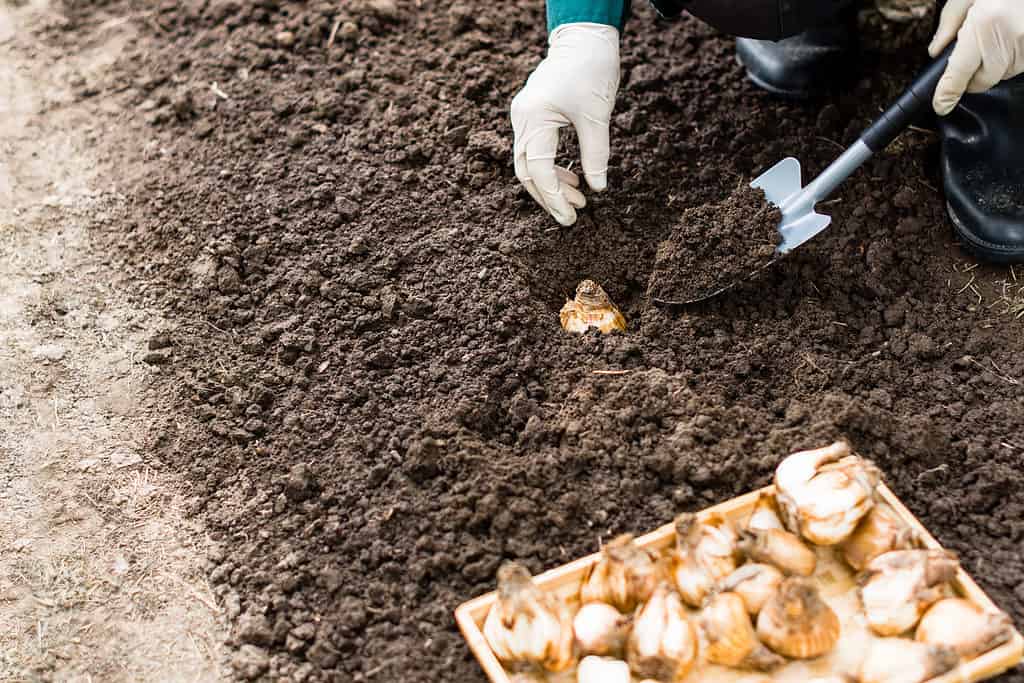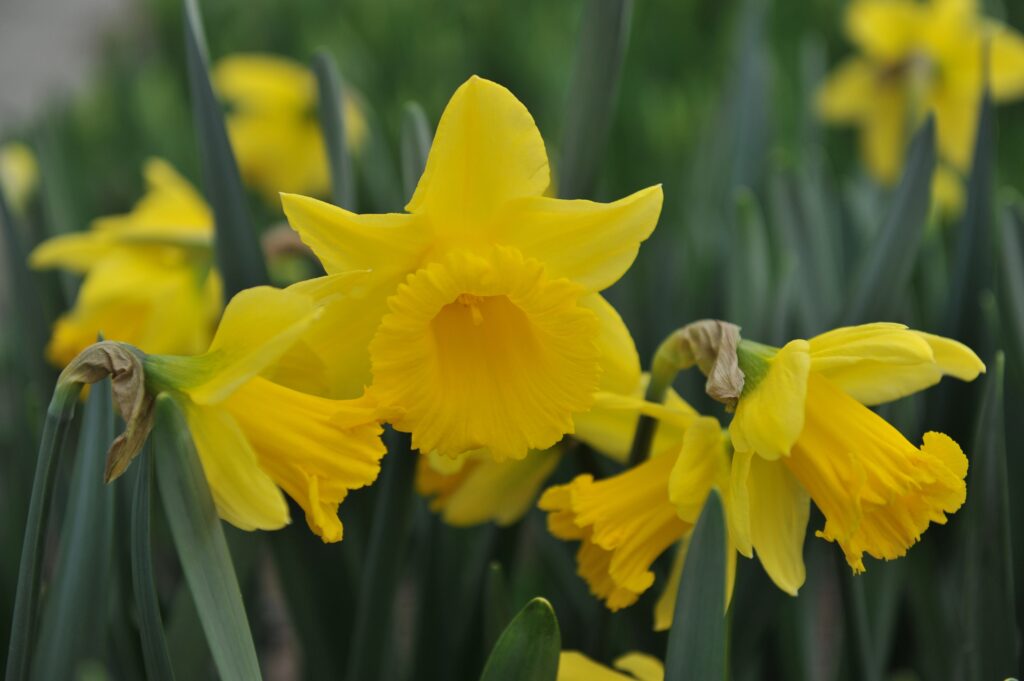As a general rule, daffodils bloom in late winter and spring. However, the specific timing of when daffodil flowers appear depends on several factors.
- First, daffodils blossom at different times based on the local climate and hardiness Zones.
- Second, daffodil flowers don’t appear on plants grown from seed as quickly as plants grown from bulbs.
- Third, the bloom time can vary depending on a daffodil’s division (classification) and cultivar.
- And finally, you can force daffodils to blossom indoors in the off-season vs. nature controlling the timing outdoors.
So when do daffodils bloom in each of these situations? Keep reading to learn more! And if you expected your daffodils to bloom this year but they didn’t, see our quick tips for figuring out why.

Most daffodils grown in the northern hemisphere will bloom between February and May.
©Susan Warren Photography/Shutterstock.com
When Do Daffodils Bloom in Different Climates and Zones
Daffodils grown outdoors in warmer climates begin to bloom earlier than those grown in colder regions. For example, daffodils that grow in the northern hemisphere typically flower between February and May. However, daffodils grown in the southern hemisphere will probably bloom in the fall.
As for USDA Hardiness Zones, the same principle applies when daffodils bloom. For instance, daffodils might bloom earlier than spring in Zones with mild winters, like Zones 9-11. But the majority of daffodils grown in colder Zones, like 3-8, produce flowers in March and April.

To enjoy their blooms much sooner, plant daffodil bulbs instead of seeds.
©Jurga Jot/Shutterstock.com
Growing Daffodils From Bulbs vs. Seeds
Daffodils grown from seeds take much more time to bloom than those grown from bulbs. Why? Because daffodil seeds need time to mature, and lots of it. In fact, it takes about 5-6 years for daffodil seeds to grow into bulbs that are mature enough to produce flowering plants.
So, if you plant daffodil bulbs in the fall, you should expect those plants to produce flowers the following spring. But if you grow daffodils from seeds, mark your calendar for five or six years from now when their first flowers should arrive!

Trumpet daffodils tend to bloom in early or mid-spring.
©Sergey V Kalyakin/Shutterstock.com
Daffodil Divisions and Cultivars
The timing of when daffodils flower could also depend on their classification and their specific cultivar. First, we’ll look at the 13 daffodil divisions and a few important differences between them. Then we’ll share some examples of how some cultivars of the same type of daffodil could also differ.
Daffodil Divisions
All daffodils are classified by divisions, and there are 13 divisions in total. Why do these divisions factor into when daffodils produce flowers? Because daffodils are grouped based on their anatomy and growth habits. So, learning the growth habits of each daffodil division helps you determine when your specific daffodils might bloom.
For instance, trumpet daffodils tend to bloom in early to mid-spring, whereas triandrus daffodils usually bloom in mid to late spring. Sometimes the difference in bloom time is subtle, but knowing these differences is beneficial for garden planning. If nothing else, now you know that when your trumpet daffodils stop blooming, your triandrus daffodils will still have flowers.
The following list includes all 13 daffodil divisions:
- Division #1 is Trumpet Daffodils
- Division #2 is Large-Cupped Daffodils
- Division #3 is Small-Cupped Daffodils
- Division #4 is Double Daffodils
- Division #5 is Triandrus Daffodils
- Division #6 is Cyclamineus Daffodils
- Division #7 is Jonquilla Daffodils
- Division #8 is Tazetta Daffodils (better for warmer climates)
- Division #9 is Poeticus Daffodils
- Division #10 is Bulbocodium Daffodils
- Division #11a is Split-Cupped Collar Daffodils
- Division #11b is Split-Cupped Papillion Daffodils
- Division #12 is Other Daffodil Cultivars
- Division #13 is Daffodils Classified Only by Botanical Name
Daffodil Cultivars
Even if you know the specific daffodil division, sometimes a daffodil cultivar has a unique blooming schedule. For example, jonquilla or jonquil daffodils typically bloom mid to late spring. However, the jonquilla cultivar Narcissus ‘Golden Echo’ could bloom in early spring in Zones 3-9.
So if you want to know when a specific daffodil cultivar blooms, check the info provided by the bulb or seed supplier.

You can force potted daffodils to bloom indoors at any time of year.
©Walter Erhardt/Shutterstock.com
When Do Daffodils Bloom Indoors vs. Outdoors
Growing daffodils indoors is a different venture than outdoor gardening. And with it comes the perk of encouraging the plants to bloom anytime you want them to! Though this practice is officially called forcing the plants to bloom, it’s a gentle and simple process.
Successfully forcing daffodils to bloom indoors requires high-quality bulbs and soil, patience, and special care. But, when done correctly, you could enjoy daffodil flowers at any time of year.
- First, daffodil bulbs need at least 10-15 weeks of underground dormancy in cold temperatures below 40 degrees Fahrenheit. So, either plan to store your potted daffodils in a cool enough area for that long or buy pre-chilled bulbs. Most pre-chilled bulbs are ready to plant immediately.
- Second, make sure your pots are well-draining, and the bulbs are planted about 6 inches below the surface with room to grow. The bulbs can be close to each other but not touching. And the pointy end of the bulbs should be facing up.
- Third, once plant shoots reach about 2 inches high, slowly introduce more warmth to the pots indoors. Start with mild temps and indirect light areas, then progress to warmer temps and direct sunlight windows.
Within a few weeks, your indoor potted daffodils should provide beautiful flowers!

Keep a gardening journal with details about the planting progress, just in case your daffodils don’t bloom.
©Gabriela Beres/Shutterstock.com
Why didn’t my daffodils bloom?
Sometimes your daffodils don’t bloom even when you think you’ve done everything right. So, if your daffodil plants didn’t produce flowers or even appear above the soil surface, here are some quick tips for figuring out why:
- Check the growing instructions for the cultivars you planted. Did you miss something important, like its hardiness in your local growing Zones? Do you know when your cultivars typically bloom?
- Also, be aware that the acidity level of your soil could affect when or if your daffodils produce flowers. Meters for testing soil pH levels are widely available and might reveal acidity issues for the types of daffodils you planted.
- Make sure the daffodil bulbs sit deep enough in the soil (about 6 inches down), with the pointed end facing up. You may have accidentally planted the bulbs with their roots facing up instead.
- Keep notes about the timing of the bulb plantings and any extreme weather changes. For example, was there an early frost or unusual rainfall? If so, extreme temperatures could throw off the timing of daffodil blooms or kill off the bulbs entirely.
- Did you recently transplant daffodil bulbs? If so, they may need extra time to adjust before blooming again.
Contact a local garden center or landscaper for more advice about what might be causing the problem. You may need to have the acidity of your soil tested by professionals or switch bulb suppliers to get your daffodils to eventually produce flowers.

Most daffodils are easy to grow and bloom again every spring.
©Sergey V Kalyakin/Shutterstock.com
Daffodils bring spring flowers, with few exceptions.
Overall, the timing of when daffodils bloom is early to late spring. Yet we’ve learned that the exact timing of daffodil flowerings depends on various factors, from the local climate to forcing potted plants to bloom indoors. However, don’t be discouraged by all those factors influencing daffodil plants! Because the truth is that daffodils are some of the easiest plants to grow.
Just do a little research about your growing Zones and cultivar growth habits for the best plant performance. If you do, you’ll see beautiful daffodil flowers on your plants very soon!
The photo featured at the top of this post is © FLORESPHOTOGRAPHIC/Shutterstock.com
Thank you for reading! Have some feedback for us? Contact the AZ Animals editorial team.






